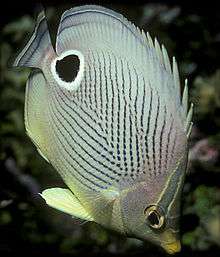Automimicry

Automimicry is a kind of intraspecific mimicry, meaning that it occurs within a single species of animal. In automimicry, not all members of a defended, aposematic species are defended to the same degree; some may actually be so weakly defended that they do not deter predators that attack them at all. These weakly defended individuals are parasitic on other members of their species to provide the negative reinforcement learning that required for warning signals to function.
History
Automimicry was first reported by the ecologist Lincoln P. Brower,[1] who found that monarch butterflies (Danaus plexippus) reared on cabbage (Brassica oleracea) were palatable to blue jays (Cyanocitta cristata bromia). However, monarchs raised on their natural host plant, milkweed (Asclepias curassavica) were noxious to jays - in fact, jays that ingested them vomited. Subsequently, Brower put forth the hypothesis of automimicry, in which a polymorphism within a species existed: some individuals might be defended, and others palatable. Many groups of animals have since been shown to obtain toxic compounds through their diets, making automimicry potentially widespread. Even if toxic compounds are produced by metabolic processes with an animal, there may still be variability in the amount that animals invest in them, so scope for automimicry remains even when dietary plasticity is not involved. Whatever the mechanism, palatability may vary with age, sex, or how recently they used their supply of toxin.[2]
Evolution
The existence of automimicry poses two challenges to evolutionary theory: how can automimicry be maintained, and how can automimicry evolve? For the first question, as long as prey of the species are, on average, unprofitable for predators to attack, automimicry can persist. If this condition is not met, then the population of the species rapidly crashes.[2] The second question is more difficult, and can also be rephrased as being about the mechanisms that keep warning signals honest. If signals were not honest, they would not be evolutionarily stable. If costs of using toxins for defence affects members of a species, then cheats might always have higher fitness than honest signallers defended by costly toxins.
A variety of hypotheses have been put forth to explain signal honesty in aposematic species. First, toxins may not be costly. There is evidence that in some cases there is no cost, and that toxic compounds may actually be beneficial for purposes other than defence.[3] If this hypothesis is true, then automimics may simply be unlucky enough not to have gathered enough toxins from their environment.
A second hypothesis for signal honesty is that there may be frequency-dependent advantages to automimicry. If predators switch between host plants that provide toxins and plants that do not, depending on the abundance of larvae on each type, then automimicry may be maintained in a balanced polymorphism.
A third hypothesis is that automimics are more likely to die or to be injured by a predator's attack. If predators carefully sample their prey and spit out any that taste bad before doing significant damage ("go-slow" behaviour[4]), then honest signallers might still have an advantage over automimics that cheat.
Potential examples of automimicry
Many species of insects are toxic or distasteful when they have fed on certain plants that contain chemicals of particular classes, but not when they have fed on plants that lack those chemicals. For instance, some species of the subfamily Danainae feed on various species of the Asclepiadoideae in the family Apocynaceae, which render them poisonous and emetic to most predators. Such insects frequently are aposematically coloured and patterned. When feeding on innocuous plants however, they are harmless and nutritious, but a bird that once has sampled a toxic specimen is unlikely to eat harmless specimens that have the same aposematic coloration.[2]
References
- ↑ Brower, Lincoln Pierson; Cook, Laurence M.; Croze, Harvey J. (March 1967). "Predator Responses to Artificial Batesian Mimics Released in a Neotropical Environment". Evolution. 21 (1): 11. doi:10.2307/2406736.
- 1 2 3 Ruxton, Graeme D.; T. N. Sherratt,; M. P. Speed (2004). Avoiding Attack: the Evolutionary Ecology of Crypsis, Warning Signals, and Mimicry. Oxford University Press.
- ↑ Leimar, Olof; Enquist, Magnus; Sillen-Tullberg, Birgitta (1 January 1986). "Evolutionary Stability of Aposematic Coloration and Prey Unprofitability: A Theoretical Analysis". The American Naturalist. 128 (4): 469–490. JSTOR 2461331.
- ↑ Guilford, Tim (October 1994). ""Go-slow" Signalling and the Problem of Automimicry". Journal of Theoretical Biology. 170 (3): 311–316. doi:10.1006/jtbi.1994.1192.
